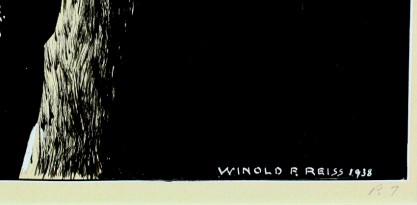

A dated 1938 and signed original mixed medium illustration by the renown American illustrator Winold Reiss used as a book plate (this appeared on page 7 of an as-of-yet unknown title) with a caption that reads, “I was so bewildered that I ran back a few yards…” Stylistically, this piece resembles a woodcut but is a large original pen and ink drawing with white gouache highlights. In the scene, an early settler in Pilgrim attire comes across a magical maiden emerging from the light in an enchanted forest. Winold Reiss was a German American muralist and illustrator that is best remembered for his portraits of the Blackfoot Indian tribe. His work was so revered by the tribe that when he died his ashes were spread across sacred burial grounds.

Reiss was deeply influenced by travels through his native German countryside with his father, a painter who made portraits of peasants. He attended art school in Munich, Germany, where he learned to work in the style known as Jugendstil (a German version of Art Nouveau). He left for the United States in 1913 filled with romantic idealism about Native Americans and the vast Western frontier.
After finding work as an illustrator and designer, Reiss drew portraits of the Blackfoot tribes of Montana, whom he befriended in 1919. The pastel drawings he produced during this period are sensitive and sympathetic depictions that capture both individual traits and a more generalized quality of human dignity. Reiss traveled to Mexico in 1920 and made portraits of workers and revolutionaries there.
In 1924 Reiss was commissioned by Survey Graphic magazine to capture the spirit of the Harlem Renaissance with portraits of the residents of Harlem in New York City. Among his subjects were visionary figures such as James Weldon Johnson, W.E.B. Du Bois, Countee Cullen, Langston Hughes, and Zora Neale Hurston. To express the rhythms and tensions of culture in Harlem, Reiss also experimented with a more abstract and angular style, as in the ink drawing Harlem at Night (1924). Reiss was later commissioned by the Great Northern Railway to provide portraits of Native Americans for a series of calendars. Not only did his work serve to document peoples in cultural transition, but it cultivated respect for his subjects.
Reiss is probably best known for his mosaic mural design for the rotunda of the Cincinnati Union Terminal, which he completed in 1933. He based his narrative on the history of transportation and its relation to Cincinnati, Ohio, with a range of anonymous, multicultural portraits of travelers, industrial workers, and builders. In this and other works, his personal themes of human integrity and the quiet heroism of everyday work were enhanced by his decorative sense of colour and line and the monumentality of his presentation.
